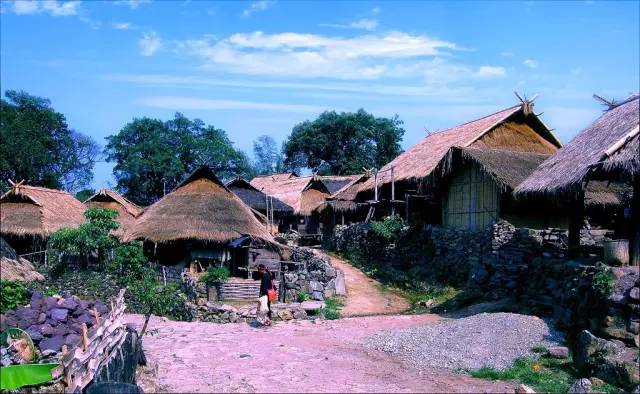
Sigangli Wa Ethnic Village in Ximeng County, Puer
Introduction
Sigangli Wa Ethnic Village (司岗里佤族村庄, Sīgānglǐ Wǎzú Cūnzhuāng) is located along Xingmeng Road in Ximeng County (西盟佤族自治县, Xīméng Wǎzú Zìzhìxiàn), Pu’er City (普洱市, Pǔ’ěr Shì), Yunnan Province (云南省, Yúnnán Shěng). This village is not only the birthplace of Wa (佤族, Wǎzú) culture but also a historical symbol for the Wa people.
Walking into Sigangli Wa Ethnic Village, you will be enveloped by rich Wa cultural ambiance. The architectural style here is unique, with most buildings constructed using traditional Wa techniques, employing bamboo, wood, and grass as primary materials—making them both eco-friendly and full of primitive charm. The village is shaded by lush trees and has fresh air, creating an otherworldly oasis.
Cultural Richness
In addition to its architectural beauty, Sigangli Wa Ethnic Village is famous for its rich Wa culture. Many traditional customs and handicrafts are preserved here, such as Wa songs and dances, embroidery, and bamboo weaving. Visitors can immerse themselves in the charm of Wa culture and experience the hospitality of the Wa people.
Natural Beauty
Sigangli Wa Ethnic Village is also surrounded by picturesque natural scenery. The village is enveloped by green mountains and clear waters, offering beautiful views of the Wa mountains. Here, you can appreciate the magnificent landscapes and feel the enchanting power of nature.
In summary, Sigangli Wa Ethnic Village is a tourist destination that integrates Wa culture, natural beauty, and cultural heritage. Whether you are interested in Wa culture or wish to connect with nature, this village is definitely worth a visit.
The Legend of Sigangli
“Sigangli” refers to a Wa legend that is prevalent in areas such as Cangyuan Wa Autonomous County (沧源佤族自治县, Cāngyuán Wǎzú Zìzhìxiàn), Ximeng Wa Autonomous County, and Lancang Lahu Autonomous County (澜沧拉祜族自治县, Láncāng Lāhù Zìzhìxiàn) in Yunnan Province. “Sigang” means “stone cave” or “gourd” in the Wa language.
Overview of the Legend
The Sigangli legend describes various stories that occurred after humans emerged from “Sigang.” It includes the origins of humanity, the creation of closely related flora and fauna, ancestral deeds, village history, family history, ethnic history, inter-ethnic relationships, heroic tales, and love stories. The content covers the Wa people’s relationship with natural phenomena, plants and animals, production and daily life, family histories, traditional customs, tribal wars, sacrifices, and survival. This extensive epic, consisting of over 5,700 lines, reflects and mirrors the entire social history and culture of the Wa people, serving as an encyclopedia of their creation history, ethnic history, development history, and spiritual history.
Main Themes
The Sigangli legend states that when the heavens and earth were first opened and humanity did not yet exist, the creator god Mu Yiji (木依吉) created humans and placed them in a stone cave. After a millet sparrow dug through the cave, the spider and Wa ancestors emerged first, followed by the Han (汉族, Hànzú), Lahu (拉祜族, Lāhù), Dai (傣族, Dǎizú), and other ethnic groups.
Wa Culture
Wa culture is often referred to as “Sigangli culture.” The Wa people have historically used the Sigangli legend to educate and guide their descendants, making it an excellent textbook for cultural education. “Sigang” also signifies unity, embodying the aspirations of the Wa ancestors for societal development, ethnic growth, and survival, serving as a moral lesson for future generations.
Research Significance
Studying Wa culture should begin with research on the Sigangli legend. This legend not only serves as an educational tool for future generations but also reflects the Wa people’s worldview, philosophy of life, cosmology, and values. Thus, we believe that Sigangli can represent Wa culture, illustrating the ancient traditions of the Wa people while indicating the direction toward advanced and excellent cultures.
Protection
In October 2023, the Ministry of Culture and Tourism of China announced the inclusion of this project in the list of national intangible cultural heritage representative projects for protection.
How to Get There
Sigangli Wa Ethnic Village is accessible by road. Visitors can take a taxi or a local bus from the center of Ximeng County to reach the village along Xingmeng Road. The scenic journey offers beautiful views of the surrounding countryside.
Travel Tips
- Best Time to Visit: Spring and autumn are ideal for experiencing pleasant weather and enjoying outdoor activities.
- Cultural Etiquette: Respect local customs and engage with the Wa community in a friendly and open manner.
- What to Bring: A camera for capturing the stunning scenery and cultural experiences, as well as comfortable shoes for walking around the village.
- Local Cuisine: Don’t miss the opportunity to try traditional Wa dishes, which are often rich in flavor and locally sourced ingredients.



















